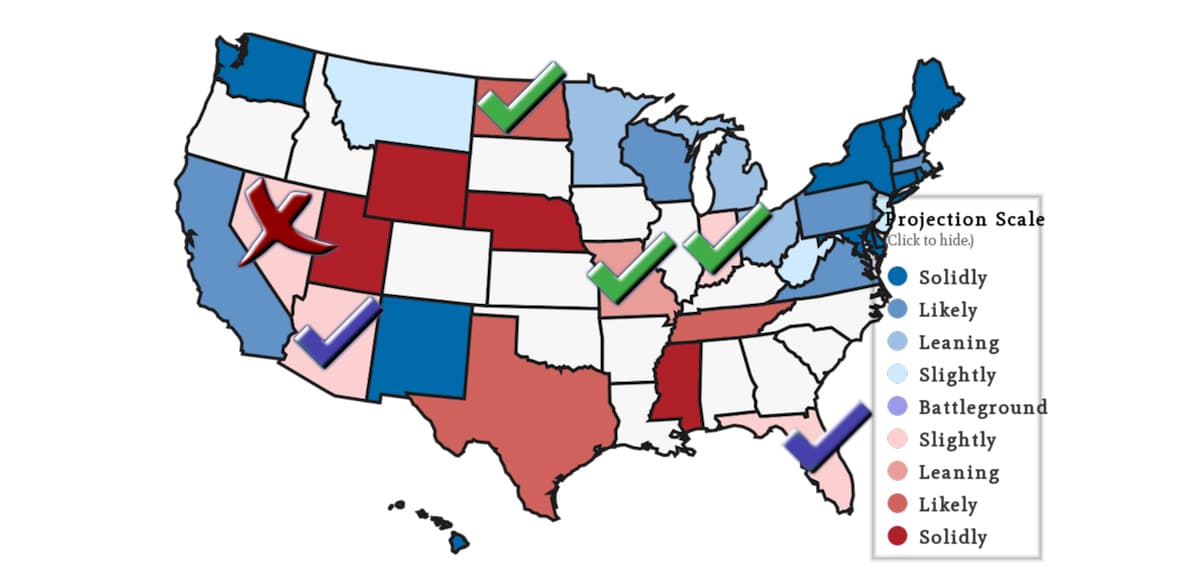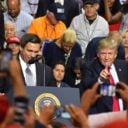

On the left, supporters take a photo of President Donald Trump in Tampa, Florida, while businessman Mike Braun, right, thanks supporters after winning the Republican primary for U.S. Senate in Indiana. (Photos: PPD/AP)
President Donald Trump and the Republican Party lost control of the newly-drawn U.S. House of Representatives. The lower chamber has garnered the most media attention and is the focus of their favorite election forecasters.
That’s unsurprising, given how badly their upper chamber models performed versus the Model-Only projection on the PPD Senate Election Projection Model.
Republicans have officially ousted three incumbent Democratic senators — Joe Donnelly in Indiana, Claire McCaskill in Missouri and Heidi Heitkamp in North Dakota. Unless hell freezes over, they are poised to net the most U.S. Senate seats for an incumbent party’s first-term midterm since 1934.
That midterm cycle, Franklin Delano Roosevelt and the Democratic Party gained 9 net seats in the U.S. House, but a stunning 9 seats in the U.S. Senate. In 2002, the Republican Party under George W. Bush gained 8 net seats in the U.S. House and just 2 in the U.S. Senate.
Let’s take a look at the very long table below (sorry). This is the history of midterm election results from 1934 to 2018. President Trump’s first-term midterm verdict is estimated for both the U.S. House and U.S. Senate, though we are confident the projection for 4 net seats will hold, more on that to follow.
[su_table responsive=”yes” class=”az-ev-district-party-totals”]
| Year | Lame Duck | President | Party | House | Senate |
|---|---|---|---|---|---|
| 1934 | Franklin D. Roosevelt | Democrat | 9 | 9 | |
| 1938 | Franklin D. Roosevelt | Democrat | -71 | -6 | |
| 1942 | Franklin D. Roosevelt | Democrat | -55 | -9 | |
| 1946 | Harry S. Truman | Democrat | -45 | -12 | |
| 1950 | Yes* | Harry S. Truman | Democrat | -29 | -6 |
| 1954 | Dwight D. Eisenhower | Democrat | -18 | -1 | |
| 1958 | Yes | Dwight D. Eisenhower | Democrat | -48 | -13 |
| 1962 | John F. Kennedy | Democrat | -4 | 3 | |
| 1966 | † | Lyndon B. Johnson | Democrat | -47 | -4 |
| 1970 | Richard Nixon | Republican | -12 | 2 | |
| 1974 | ± | Gerald R. Ford (Nixon) | Republican | -48 | -5 |
| 1978 | Jimmy Carter | Democrat | -15 | -3 | |
| 1982 | Ronald Reagan | Republican | -26 | 1 | |
| 1986 | Yes | Ronald Reagan | Republican | -5 | -8 |
| 1990 | George Bush | Republican | -8 | -1 | |
| 1994 | William J. Clinton | Democrat | -52 | -8 | |
| 1998 | Yes | William J. Clinton | Democrat | 5 | 0 |
| 2002 | George W. Bush | Republican | 8 | 2 | |
| 2006 | Yes | George W. Bush | Republican | -30 | -6 |
| 2010 | Barack Obama | Democrat | -63 | -6 | |
| 2014 | Yes | Barack Obama | Democrat | -13 | -9 |
| 2018 | Donald Trump | Republican | -29 to -35 | 3-4 |
[/su_table]
• A “lame-duck” mid-term election is when the incumbent president is constitutionally prohibited from seeking re-election in the next scheduled presidential election. We note common exceptions below.
* Harry S. Truman was not constitutionally prohibited from running for a third term in 1952, but he chose not to seek re-election.
† Lyndon B. Johnson was not a lame-duck president in 1966, but in March 1968 he chose not to seek re-election.
± Gerald Ford was not a lame-duck president and did run for re-election in 1976, but the 1974 mid-term election took place only 3 months after the resignation of Richard M. Nixon and only 2 months following the pardon.
In Florida, incumbent Democratic Senator Bill Nelson has been defeated by popular Republican Governor Rick Scott, albeit the margin stands at 0.4%. But the senatorial contest is headed for a recount. State law requires that be completed by Saturday.
Again, we do not expect this to change the outcome barring any shenanigans and Mr. Nelson will become the fourth incumbent Democrat to be defeated that night. The final five precincts in Miami-Dade are in, and Governor Scott is receiving more than 40% of the vote.
For those watching the governor’s margin, it’ll shrink only slightly when the last 5 precincts in Miami-Dade — which have been added to the U.S. Senate vote total — are also included.
The presence of third-party candidates helped to widen Governor-elect Ron DeSantis’ margin over leftwing Democratic candidate Andrew Gillum. Mr. Gillum conceded and, knowing what checkmate looks like in Florida, Mr. Nelson was reportedly going to conceded until the party and money called.
Regardless, it’s been counted and estimated by the model, and it’s not enough.

Source: PPD Senate Election Projection Model
When all the votes are counted in Arizona, the PPD Election Projection Model projects Martha McSally the winner by a margin ranging from 0.2% to 0.7%, depending on the spreads in the estimated outstanding vote. There is still a slight chance Kyrsten Sinema ekes out a 0.2% victory if the vote is heavily lopsided in her favor.
We do not expect that to happen. In fact, it’s also possible Rep. McSally’s lead increases slightly.
Given the location of the remaining vote and the standing margins, a rough net of 22,000 in Pima County (20K net) and Santa Cruz (2K net) will be offset by remaining vote for Rep. McSally in Yavapai, Pima and Yuma.
If it holds, President Trump and Republicans would post a 5-seat gain, netting 4 with Senator Dean Heller losing in Nevada. Even if one of those projections don’t hold, it would still be the largest midterm gain in the U.S. Senate for a first-term incumbent president and party since 1962.
John F. Kennedy and the Democratic Party gained 3 seats in the 1962 midterm elections. But with that year all but officially beat, we’d have to go back to FDR, a president the nation once viewed to be their father during times of desperate need.
While it may be hard for his critics to swallow, it’s a historic feat. More notably, it’s one we can confidently argue never would’ve happened without the president touring the country. No one motivates the Republican base like Donald J. Trump and, given the historic levels of opposition turnout, the Republican Party would’ve been wiped out.
Instead, the result was an average defeat in the U.S. House and an above average victory in the U.S. Senate for President Trump and the Republican Party.








Uli / November 8, 2018
I didn’t know Eisenhower was a democrat.
/